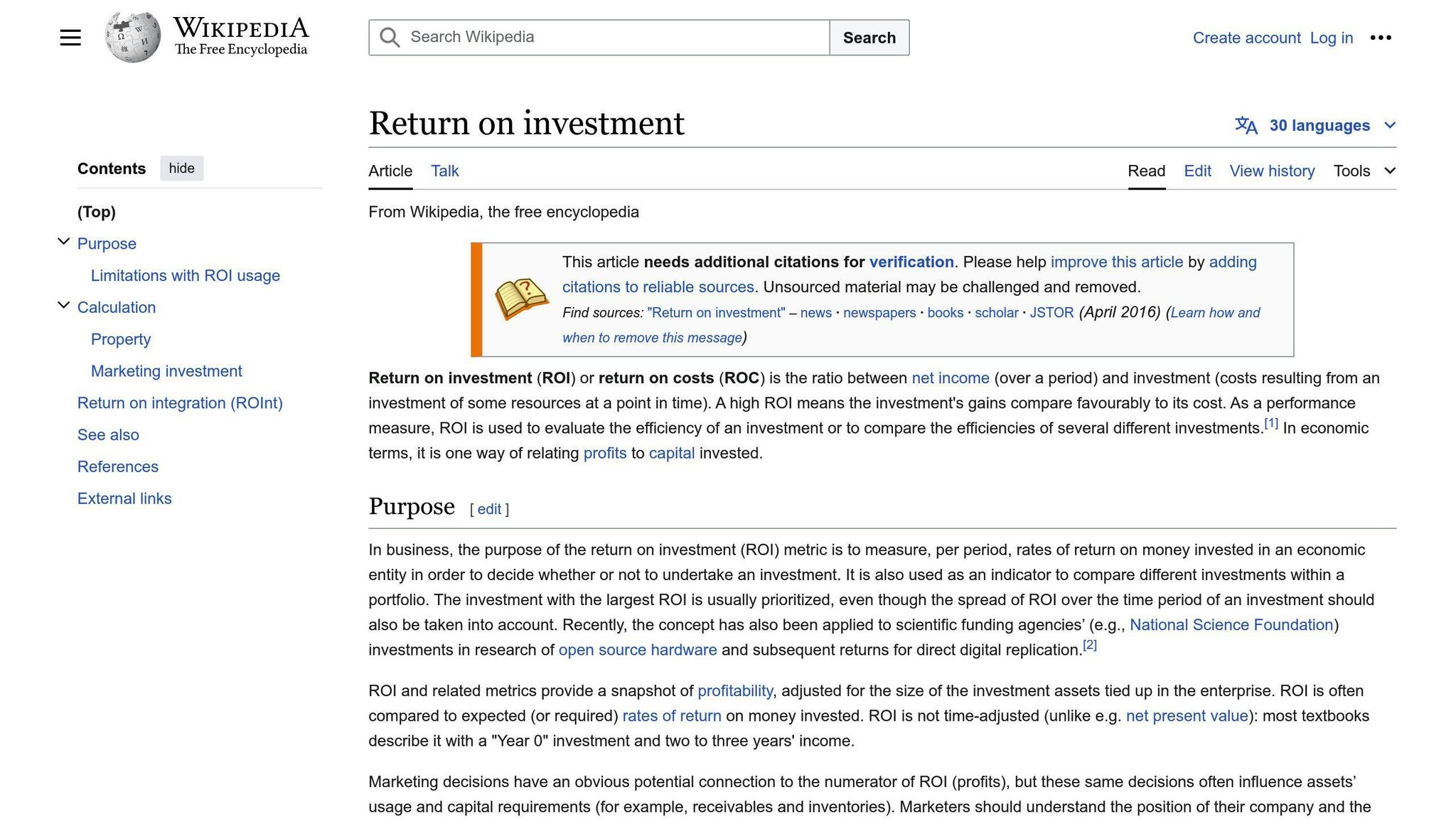During tough economic times, it's crucial to optimize your marketing budget for maximum impact. Here are 6 tips to get the most out of your marketing spend:
-
Assess Your Current Situation
- Identify high-ROI activities and cut wasteful spending
- Look for opportunities to negotiate better rates
- Prioritize quick wins and avoid complex long-term projects
- Prioritize High-ROI Channels
-
Leverage Existing Assets
- Reuse and refresh top-performing content and campaigns
- Update assets with user data for better relevance
-
Optimize Your Marketing Mix
- Shift budgets to the most cost-effective tactics and channels
- Continuously test and refine the mix for maximum ROI
-
Enhance Customer Retention
- Keeping current customers is cheaper than acquiring new ones
- Use data for personalized retention efforts and loyalty programs
-
Embrace Agility and Flexibility
- Respond quickly to changing conditions and new opportunities
- Test, optimize, and pivot campaigns for better returns
| Tip | Impact on ROI | Cost Efficiency | Implementation Time | Scalability |
|---|---|---|---|---|
| 1. Assess Your Current Situation | High | High | Short | Moderate |
| 2. Prioritize High-ROI Channels | High | High | Moderate | High |
| 3. Leverage Existing Assets | Moderate | High | Short | Moderate |
| 4. Optimize Your Marketing Mix | High | Moderate | Moderate | High |
| 5. Enhance Customer Retention | High | High | Moderate | Moderate |
| 6. Embrace Agility and Flexibility | High | High | Short | High |
By following these tips, you can maximize your marketing budget's effectiveness, save money, and position your brand for success during challenging times.
Related video from YouTube
1. Assess Your Current Situation
Impact on ROI

- Check how the crisis has changed your marketing ROI across different channels and campaigns.
- Find areas where ROI has dropped and figure out why (e.g., lower demand, supply chain problems).
- Estimate the potential ROI if you move budgets to better-performing channels.
Cost Efficiency
- Review your marketing spending to spot waste or inefficiency.
- Look for chances to negotiate better rates with vendors or service providers.
- Think about bringing some outsourced marketing tasks in-house if it saves money.
Implementation Time
- See how quickly you can change marketing strategies and shift budgets.
- Focus on actions that can be done quickly to get short-term results.
- Avoid complex, long-term projects that might be disrupted by the crisis.
Scalability
- Check if your marketing tactics and technology can scale up or down easily.
- Choose flexible solutions that can adjust based on demand.
- Avoid rigid contracts that limit your ability to change.
2. Prioritize High-ROI Channels
Impact on ROI
- Analyze which marketing channels are giving the best returns during the crisis.
- Move budgets to channels with proven returns, even if they weren't top choices before.
- Channels like email, social media, SEO, and PPC might be more cost-effective.
Cost Efficiency
- Check the cost per acquisition for each channel to find the most efficient ones.
- Negotiate better rates with vendors for high-return channels.
- Consider pausing or cutting spend on costly channels with lower returns.
Implementation Time
- Focus on channels you can optimize or scale quickly for short-term results.
- Use existing assets and data to boost high-return channels fast.
- Avoid long implementations that might be disrupted by the crisis.
Scalability
- Pick marketing channels that let you easily scale budgets up or down.
- Choose channels with performance-based pricing over fixed costs.
- Use tools and technologies that allow flexible budget and campaign management.
3. Leverage Existing Assets
Impact on ROI
- Reuse old content and campaigns to save money.
- Update top-performing assets to get more value from them.
- Use user data to create more relevant content.
Cost Efficiency
- Reusing assets cuts down on creation costs.
- Refreshing old content is cheaper than making new content.
- Redeploying successful past campaigns saves money.
Implementation Time
- Updating old assets is faster than creating new ones.
- Using data insights helps optimize assets quickly.
- Repurposing successful campaigns speeds up time-to-market.
Scalability
- Existing assets can be used on new channels and for new audiences.
- Proven content can be shared across different platforms.
- Data-driven optimization keeps assets relevant as needs change.
sbb-itb-5c5ac24
4. Optimize Your Marketing Mix
Impact on ROI
- Shift budget to high-performing channels for better returns.
- Use data to find the most cost-effective marketing tactics.
- Continuously test and refine the channel mix to maximize ROI.
Cost Efficiency
- Cut spending on low-ROI channels.
- Focus on proven, efficient marketing activities.
- Use low-cost channels like email, social media, and content marketing.
Implementation Time
- Quickly reallocate budgets to responsive channels.
- Test new channel mixes to find the best combinations.
- Use existing assets to launch new campaigns faster.
Scalability
- Adjust the channel mix for different audience segments.
- Easily scale high-ROI channels up or down as needed.
- Change the marketing mix as situations change.
5. Enhance Customer Retention
Impact on ROI
- Keeping current customers is cheaper than finding new ones.
- Loyal customers spend more over time.
- Happy customers tell others, bringing in new business.
Cost Efficiency
- Use customer data to make retention efforts personal.
- Set up loyalty programs and rewards that don't cost much.
- Improve self-service options to cut support costs.
Implementation Time
- Reach out to customers at risk of leaving quickly.
- Change retention plans based on customer feedback fast.
- Use automation for timely, personal messages.
Scalability
- Group customers by behavior, likes, and value.
- Apply retention methods across different channels.
- Use data to keep improving retention strategies.
6. Embrace Agility and Flexibility
Impact on ROI
- Quickly shift strategies to seize new opportunities.
- Respond fast to changing market conditions or customer needs.
- Test and optimize campaigns for better returns.
Cost Efficiency
- Cut spending on underperforming campaigns or channels.
- Move budget to higher-yielding tactics.
- Avoid costs from long-term commitments.
Implementation Time
- Agile processes speed up new ideas or pivots.
- Faster approvals and decision-making.
- Continuous monitoring allows quick adjustments.
Scalability
- Easily scale strategies up or down based on results.
- Agile processes fit changing team structures or workloads.
- Data-driven optimization supports growth and scalability.
Comparing the Tips
When optimizing your marketing budget during a crisis, consider the impact on ROI, cost efficiency, implementation time, and scalability of each tip. Here's a comparison:
| Tip | Impact on ROI | Cost Efficiency | Implementation Time | Scalability |
|---|---|---|---|---|
| 1. Assess Your Current Situation | High - Focuses resources on high-yield activities | High - Cuts wasteful spending | Short - Quick to do | Moderate - Easier to scale effective tactics |
| 2. Prioritize High-ROI Channels | High - Maximizes returns | High - Budgets top performers | Moderate - May need channel testing | High - Top channels can scale easily |
| 3. Leverage Existing Assets | Moderate - Saves costs by reusing assets | High - Uses existing resources | Short - Quick to implement | Moderate - Limited by existing assets |
| 4. Optimize Your Marketing Mix | High - Balanced mix drives better results | Moderate - Reallocating budget takes effort | Moderate - Needs testing and analysis | High - Optimized mix can scale well |
| 5. Enhance Customer Retention | High - Retaining customers is cost-effective | High - Costs less than acquiring new ones | Moderate - Needs customer analysis | Moderate - Depends on customer base size |
| 6. Embrace Agility and Flexibility | High - Allows quick pivots for opportunities | High - Avoids wasted spend on underperformers | Short - Agile processes enable rapid changes | High - Agility supports scalability |
Final Thoughts
Optimizing your marketing budget during a crisis is key to staying strong and growing. By following these six tips, you can get the best returns, save money, and set your brand up for success.
- Assess your current situation: Identify high-yield activities and cut wasteful spending.
- Prioritize high-ROI channels: Focus on channels that deliver results and match your audience's behavior.
- Leverage existing assets: Save costs by reusing content and maintaining a consistent brand presence.
- Optimize your marketing mix: Reallocate budgets to the most effective tactics and channels.
- Enhance customer retention: Nurture your existing customer base cost-effectively.
- Embrace agility and flexibility: Pivot quickly and seize new opportunities.

![Thumbnail for: Cross-Selling & Upselling: 10 Strategies [2024]](https://mars-images.imgix.net/seobot/cmoindex.com/6647fa8465774bd9ef96fd2e-d8175c825036099a4d9cfed86841ae56.png?auto=compress)

